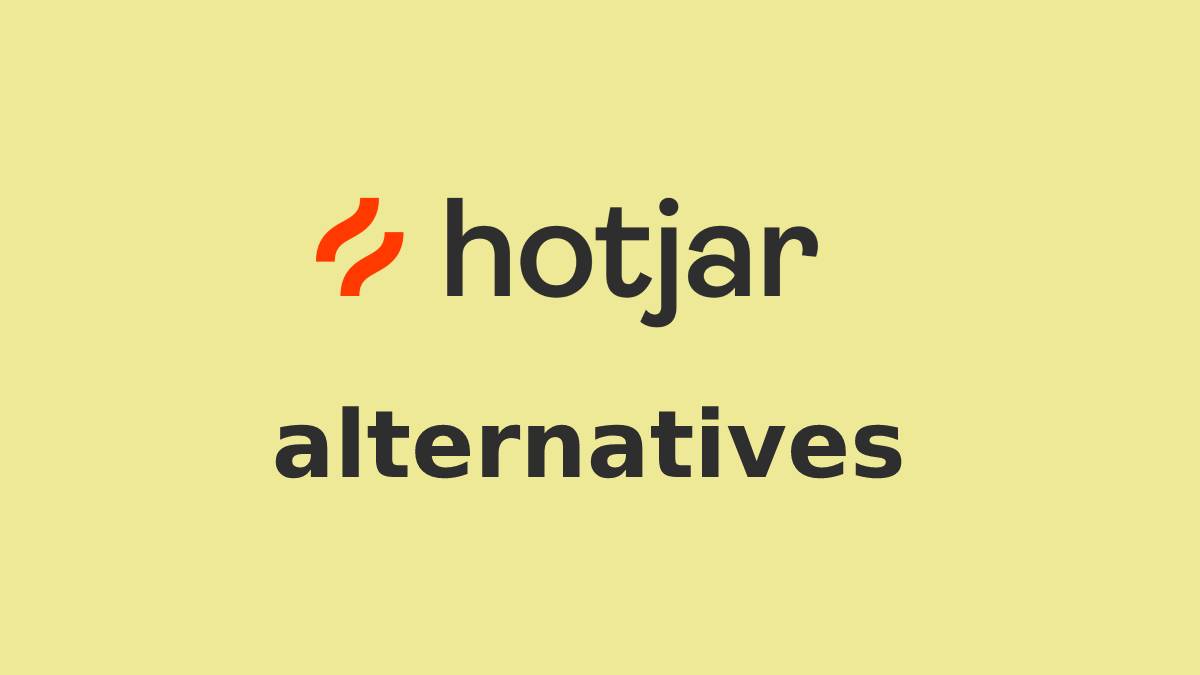Many people turn to Hotjar as their first choice for analyzing user behavior. However, Hotjar’s capabilities have limitations that experienced marketers, product managers, and UX professionals may find problematic:
- The platform no longer offers funnel analysis features, meaning that users who want to see where their visitors are dropping off in a funnel must pay for an additional tool or go through the cumbersome process of manually integrating Google Analytics.
- Additionally, defining and tracking events on Hotjar requires programming and a paid plan, which could be a significant hurdle for those without technical skills.
- Event tracking on Hotjar is further limited by the inability to use events to create funnels, which is an essential use case for this type of tracking.
- Finally, compared to many other tools on the market, Hotjar’s quantitative analysis capabilities are notably limited.
As a result of these limitations, many professionals are looking for other options beyond Hotjar to analyze user behavior. To that end, we’ve compiled a list of 10 top Hotjar alternatives.
First up is UXsniff, which is our website analytics tool. UXsniff provides a comprehensive suite of features, including heatmaps, session recordings, feedback widget, and on-site surveys, making it a powerful option for those seeking to understand user behavior.
10 Top Hotjar Alternatives for Behavior Analysis Using Heatmaps, Session Recordings, Feedback, and Surveys
UXsniff
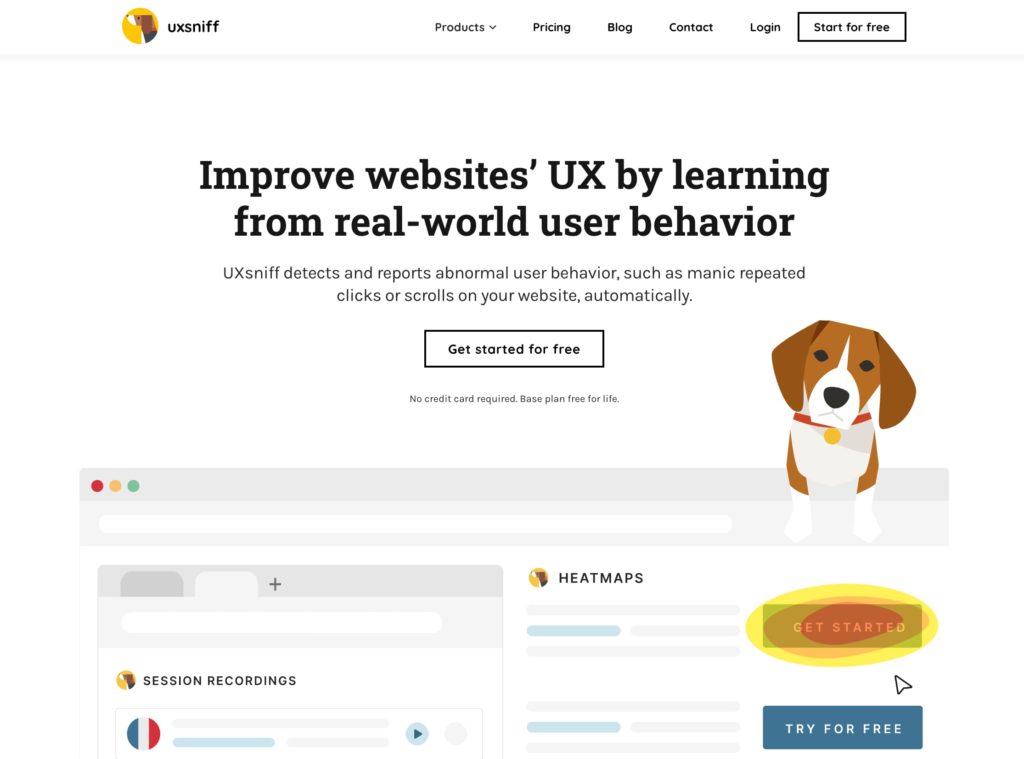
- Website heatmaps: Yes, auto capture
- Session recording: Yes, auto capture, AI summaries.
- Feedback: Yes, included in free plan
- Surveys: Yes, included in free plan
- Free Plan: Available for up to 4,500 pageviews/month. No credit card required.
- Price: Paid plans start at $9/month, with a 14-day free trial.
Once you’ve installed UXsniff’s code snippet, the platform’s session recording feature automatically captures every user session on your website. You can leverage this session data to define events, create heatmaps, and watch user recordings to gain valuable insights into user behavior.
This has a few benefits:
- You don’t have to manage session recordings manually.
- When you receive feedback or a survey response, it will automatically link to the associated user recording.
- UXsniff can easily learn and detect unusually click activities, since the relevant data has already been collected.
Both UXsniff and Hotjar offer session recordings and heatmaps to track clicks, scrolls, and mouse movements, among other features.
UXsniff’s session recordings are always on by default, capturing every user session. In comparison, Hotjar’s Continuous Capture can record all user sessions as long as session capture is enabled. However, in some cases, Hotjar may still sample your traffic unless you manually adjust session targeting or upgrade to a higher plan.
Although Hotjar has excellent features for soliciting feedback from website visitors, UXsniff enables you to gain a deeper understanding of their behavior and quantify it using advanced features such as:
- Automatic rage click detection, which detects unusual clicking patterns and reports them using email or Slack notifications.
- Time Travel A/B Testing, revisit your past designs like a pro. With UXSniff, your site becomes your own Wayback Machine — view old heatmaps, compare versions, and run retro A/B tests with zero setup or traffic split.
- Real-time analytics observe your users’ behavior in real time.
- The User Identity API can be integrated by placing an additional code snippet on your website to identify the user’s ID during session recording.
FullStory
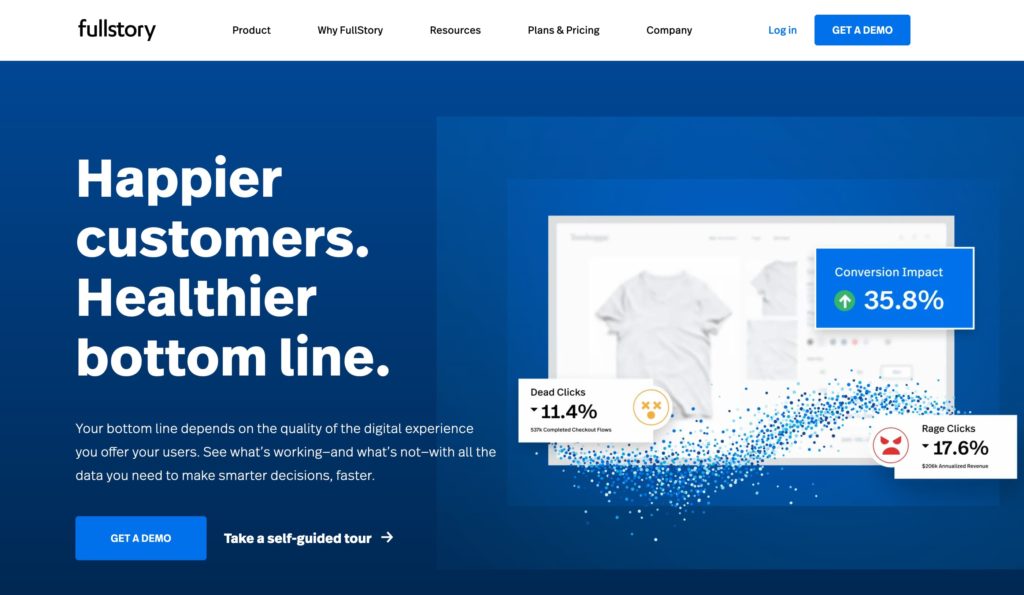
- Website heatmaps: Yes, auto capture
- Session recording: Yes, auto capture
- Feedback: Yes, included in free plan
- Surveys: Yes, included in free plan
- Free Plan: Available for up to 1,000 sessions/month with all features.
- Price: Paid plans start at $9/month, with a 14-day free trial.
To find out how much the business and enterprise plans cost, you need to ask for the pricing information. Certain paid plans have a trial period of two weeks.
FullStory is a platform that provides “Digital Experience Intelligence” and includes an advanced tool for replaying user sessions. Additionally, it offers features for analyzing user funnels, as well as the ability to segment and filter users based on their actions, among other capabilities.
FullStory is primarily designed for enterprise users, and this is an important factor to consider. As a result, the platform’s cost is relatively high, which is frequently mentioned in online reviews.
Both FullStory and Hotjar provide heatmaps and the ability to watch user sessions. However, Hotjar stands out with its feedback and survey features, while FullStory offers more extensive quantitative analytics capabilities, including funnel analysis and mobile app analysis in addition to website analysis.
One significant difference between the two tools is pricing transparency. Hotjar has four pricing plans with transparent pricing based on user sessions, while FullStory requires you to contact their team to receive a quote.
Contentsquare
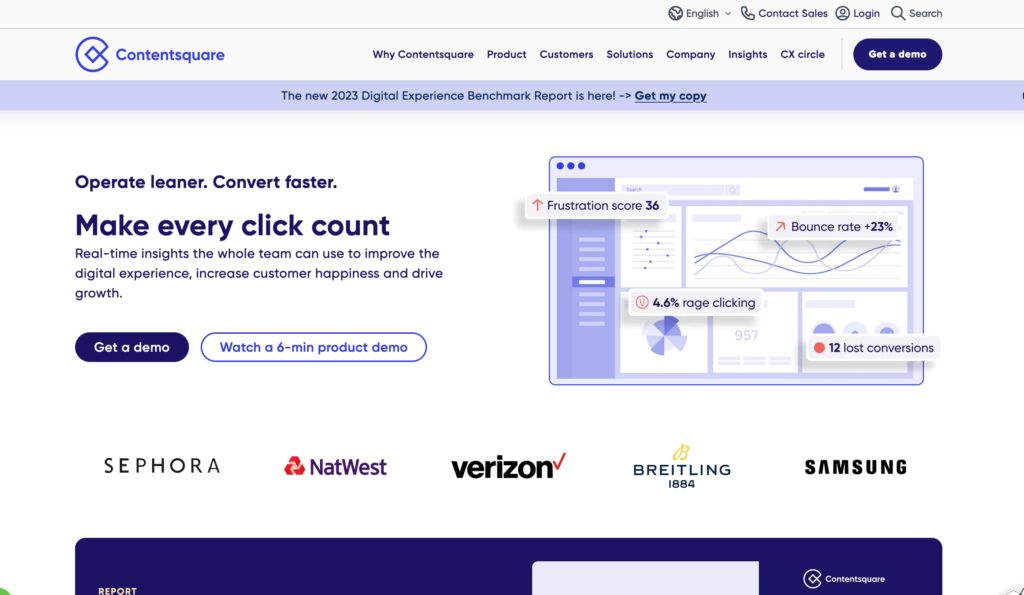
- Website heatmaps: Yes
- Session recording: Yes
- Feedback: Yes
- Surveys: Yes
- Free Plan: No information besides a free product demo.
- Price: Price is available upon a request to their sales team.
Contentsquare is a web analytics platform that is very large and, as of September 2021, owns Hotjar. In addition, they acquired Clicktale in 2019, which used to be one of Hotjar’s competitors.
Contentsquare is a platform that offers multiple features to analyze and enhance the customer experience, including user journey analysis, heatmaps, session replays, and AI insights. Like FullStory, Contentsquare primarily caters to enterprise users and provides a toolset with features for different teams, such as product, UX, marketing, e-commerce, IT, operations, and customer support.
Contentsquare offers a broader range of capabilities compared to Hotjar, which is why they refer to themselves as a “digital experience analytics cloud.” Both tools offer features such as heatmaps and screen recordings, with Contentsquare having additional features like revenue and conversion metrics. While Hotjar has strong feedback and survey features, Contentsquare is a more comprehensive analytics platform for both websites and mobile apps.
However, Contentsquare’s pricing isn’t transparent, and you need to go through a demo to get a quote.
VMO
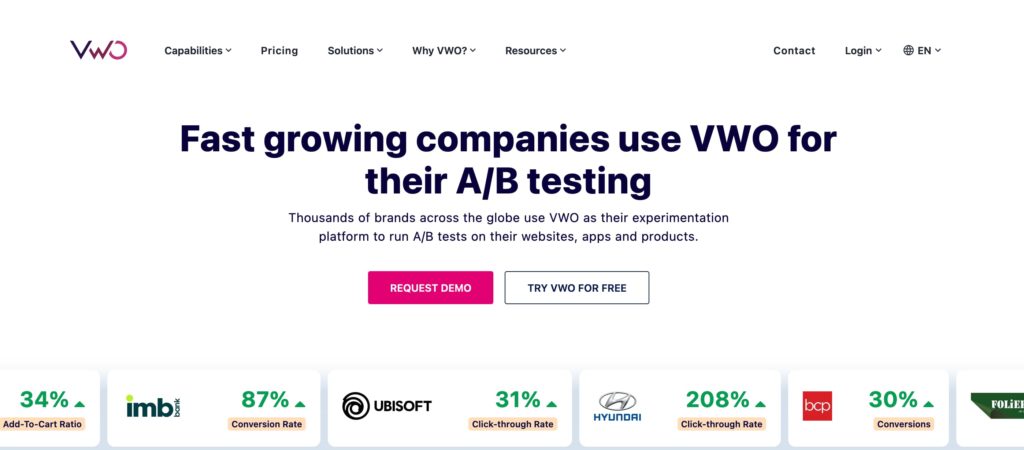
- Website heatmaps: Yes
- Session recording: Yes
- Feedback: Yes
- Surveys: Yes
- Free Plan: 30-day free trial. No credit card required.
- Price: Price is available upon a request to their sales team.
VWO is a conversion rate optimization (CRO) platform that focuses on improving user experience metrics and conversions through A/B, multivariate, and split URL testing. Additionally, VWO has several other features, such as product testing, push notification sending, and more.
VWO is a tool that offers a wide range of features and capabilities similar to Contentsquare. It also has all of the features available on Hotjar, including heatmaps, screen recordings, and on-page feedback and surveys. Additionally, VWO can be used to analyze forms and funnels, which are no longer available on Hotjar.
Furthermore, VWO’s A/B, multivariate, and split URL testing capabilities make it a valuable tool for CRO professionals. However, unlike other tools on the list, VWO’s pricing is not publicly available. Some VWO users have reported that additional fees may apply to watch more user session recordings.
Crazy Egg
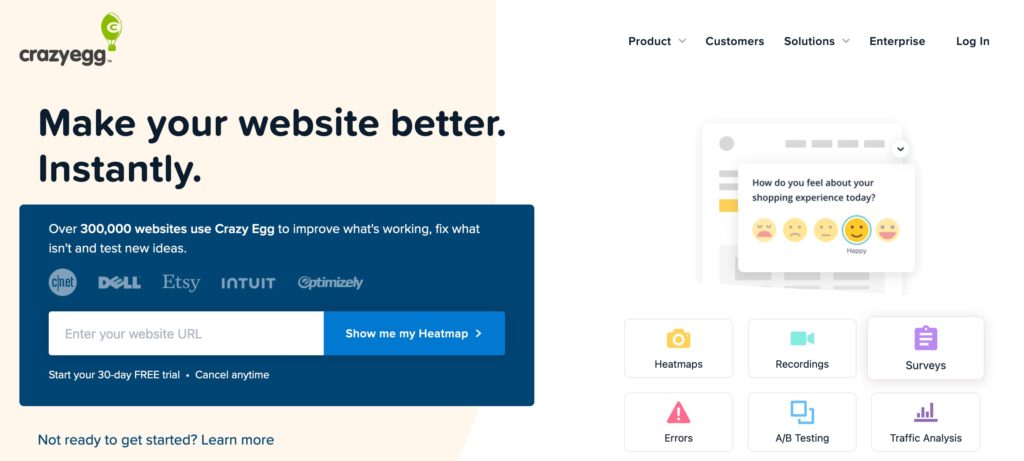
- Website heatmaps: Yes
- Session recording: Yes
- Feedback: Yes
- Surveys: Yes
- Free Plan: No free plan available.
- Price: Plans start at $24/month, with a 30-day free trial.
- All plans are billed annually.
Crazy Egg is a tool for web analytics and conversion rate optimization (CRO). It offers a range of features, including heatmaps, user recordings, A/B testing, and ad traffic tracking for your website.
Crazy Egg and Hotjar are two digital experience analytics tools that provide heatmaps and screen recordings to help businesses understand their website visitors’ behavior. However, there are some differences between them.
Crazy Egg samples website traffic, allowing you to choose the sampling rate, while Hotjar records every user session. This means that Hotjar has more comprehensive quantitative analytics capabilities than Crazy Egg.
Hotjar excels in user feedback and surveys, while Crazy Egg offers A/B testing. When it comes to pricing, there is a significant difference between the two tools in the number of user sessions you can record. Hotjar’s free version allows up to 1,050 user recordings per month, while Crazy Egg’s $99/month plan only includes 1,000 user recordings.
Mouseflow
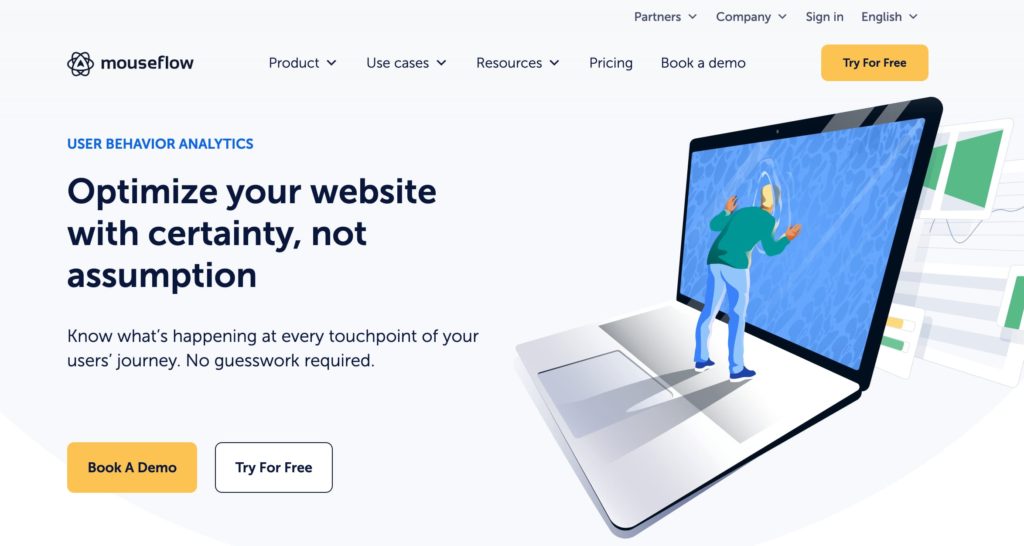
- Website heatmaps: Yes
- Session recording: Yes
- Feedback: Yes
- Surveys: Yes
- Free Plan: Available for up to 500 recordings/month.
- Price: Paid plans start at $24/month with a 14-day free trial. No credit card required.
Mouseflow is a SaaS tool that provides website owners with valuable insights into their visitors’ behavior, helping them to understand why visitors may not convert. It offers a range of features, including heatmaps, session replays, and conversion funnels, among others, all aimed at providing a comprehensive understanding of user behavior on the website.
Mouseflow and Hotjar are digital experience analytics tools that share some features such as heatmaps, screen recordings, and user feedback options. However, Mouseflow stands out with its form analytics and conversion funnels capabilities, which Hotjar has retired.
Mouseflow offers flexibility in recording all website users or only a percentage of them, while Hotjar records every user session. Mouseflow has four paid plans and a slightly better price-to-user recording ratio, whereas Hotjar retains data for more extended periods on their free and cheaper plans despite having three plans.
Overall, Mouseflow and Hotjar have their own strengths and unique features that businesses can choose from depending on their specific needs and budget.
Clarity
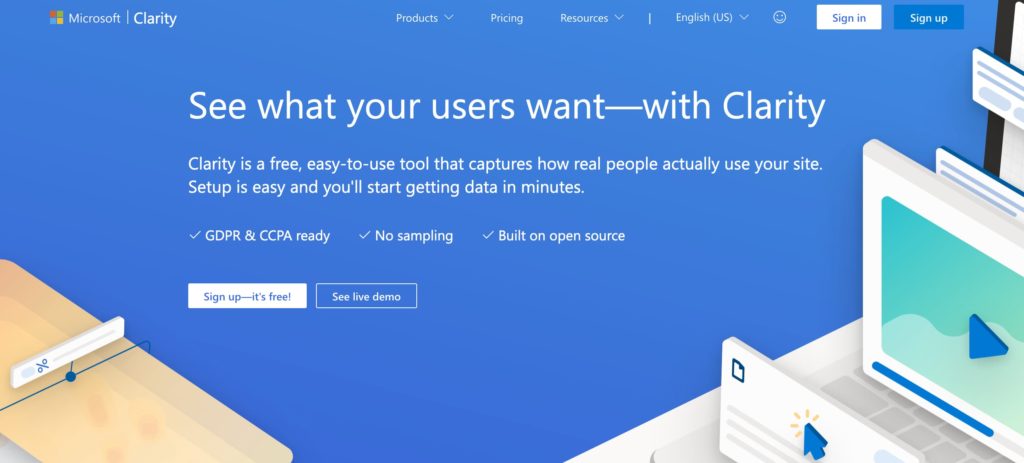
- Website heatmaps: Yes
- Session recording: Yes
- Feedback: No
- Surveys: No
- Free Plan: Clarity is a free open-source tool from Microsoft offering unlimited recordings, unlimited websites, and unlimited team members.
- Price: Clarity has no paid plans.
Clarity, a behavior analytics tool from Microsoft, is a free alternative to Hotjar that includes session recordings, heatmaps, automated insights, and integration with Google Analytics.
Clarity is useful for session recordings and heatmaps, offering unlimited heatmaps and over 25 filter options that can be applied to both recordings and heatmaps. It also automatically displays sessions that may indicate friction points on your website.
However, Clarity doesn’t provide funnel analysis, surveys, or any tools for gathering customer feedback.
Plerdy
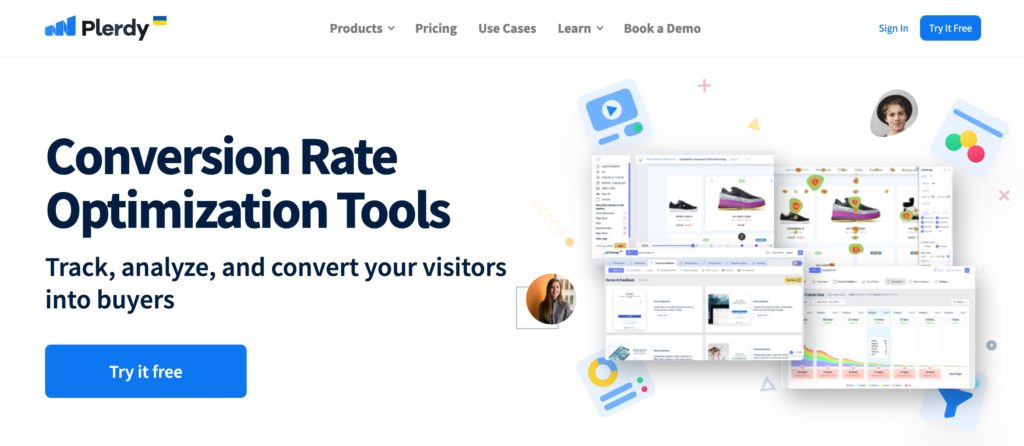
- Website heatmaps: Yes
- Session recording: Yes
- Feedback: Yes
- Surveys: Yes
- Free Plan: Available for up to 2,000 page views/day.
- Price: Paidplans start at $23/month, with a 14-day free trial. There are different plans based on which features you want to use.
Plerdy offers solutions for various website analytics use cases, including quantitative website analytics, user behavior analysis, and SEO.
Plerdy has many of the same features as Hotjar, such as heatmaps, screen recordings, and surveys, but it only offers Net Promoter Score (NPS) surveys, unlike Hotjar.
Plerdy’s pricing plans vary based on the scope of its features, and its behavior analytics plans are less cost-effective than Hotjar’s. For example, Hotjar’s $39/month plan captures 3,000 recordings, while Plerdy’s $47/month plan only captures 2,000 with a shorter storage period.
Inspectlet
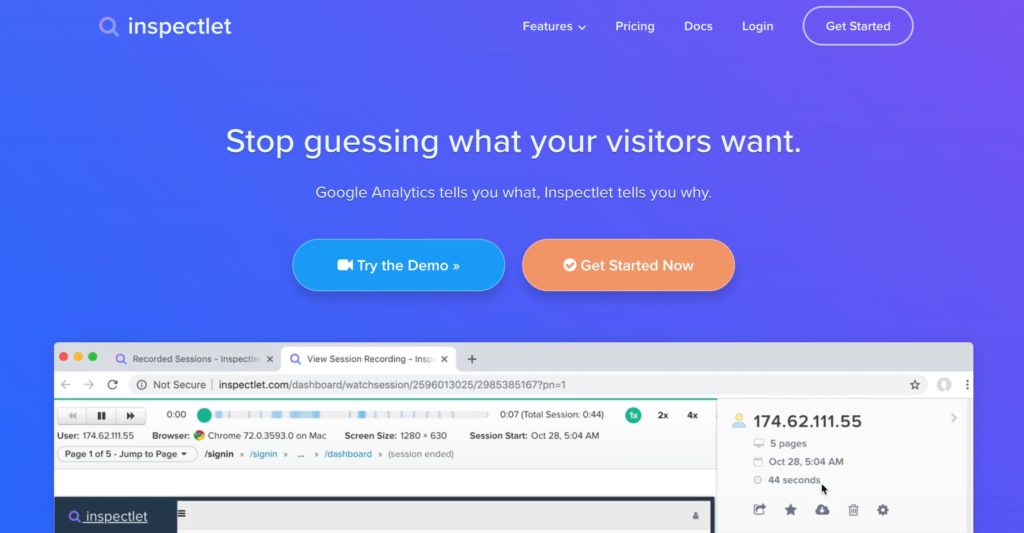
- Website heatmaps: Yes
- Session recording: Yes
- Feedback: Yes
- Surveys: Yes
- Free Plan: Available for up to 2,500 recorded sessions/month.
- Price: Paid plans start at $39/month.
Inspectlet is a website analytics tool that offers a mix of CRO and debugging features such as A/B testing and error logging.
Inspectlet’s features are similar to those of Hotjar, including session recordings, heatmaps, and feedback surveys, although they have some limitations in terms of events and funnels.
Inspectlet has an advantage in three areas: A/B testing, form analytics, and error logging. It also offers more recorded sessions at a similar price point to Hotjar. However, data storage times are shorter for Inspectlet’s lower-priced plans, lasting from 1 to 6 months.
Inspectlet’s data collection works differently from other tools, staggering session recordings by default. This approach can result in missing important recordings, but it can also prevent exceeding monthly quotas.
Lucky Orange
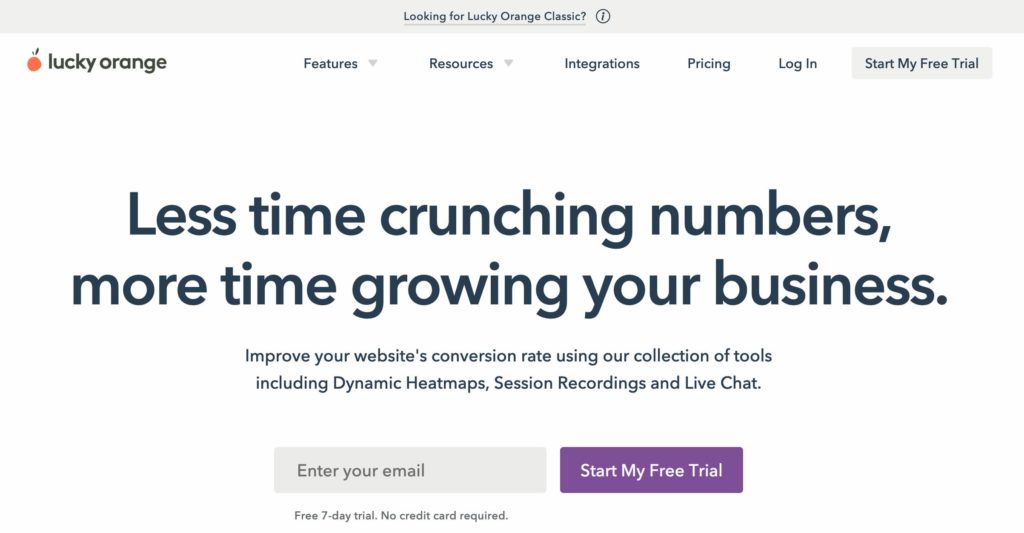
- Website heatmaps: Yes
- Session recording: Yes
- Feedback: Yes
- Surveys: Yes
- Free Plan: Available for up to 500 page views/month.
- Price: Paid plans start at $10/month, with a 7-day free trial. No credit card required.
Lucky Orange is a tool that analyzes visitor behavior on websites through features like heatmaps and session recordings. It also includes tools for improving conversion rates, such as funnels, form analytics, and live chat.
Hotjar’s previous version offers similar features, but Lucky Orange sets itself apart with its conversion funnel and form analytics capabilities. Additionally, Lucky Orange provides live chat and pop-up announcements to aid in conversion rate optimization.
In terms of pricing, Lucky Orange offers more options, including affordable plans for startups and small businesses, as well as an enterprise plan. However, it’s worth noting that Hotjar stores data for 365 days for all its plans, while Lucky Orange’s standard plans only retain data for 30 days, including the $100/month plan.
